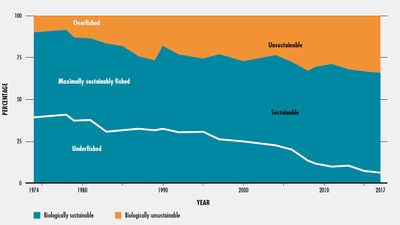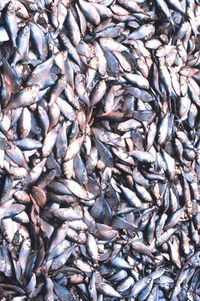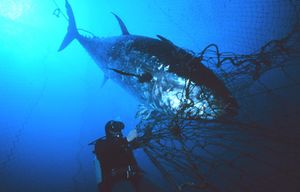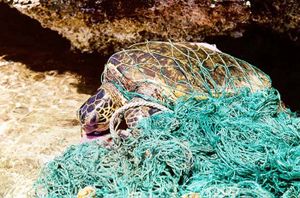Overexploitation
Definition of Overexploitation:
In ecology: The use or extraction of a resource to the point of exhaustion or extinction.
In fishery: The rate of exploitation where the resource stock is drawn below the size that, on average, would support the long-term maximum sustainable yield (MSY) of the fishery. This is the common definition for Overexploitation, other definitions can be discussed in the article
|
Overexploitation or overfishing is the removal of marine living resources to levels that are too low for sustaining viable populations. Ultimately, overexploitation can lead to resource depletion and put a number of threatened and endangered species at risk of extinction. See also the article Species extinction.
A greater variety of species at a higher trophic level is exploited in the sea than on land: humans exploit over 400 species as food resources from the marine environment; whereas on land only tens of species are harvested for commercial use. Exploitation of marine biodiversity is also far less managed than on land and amounts to the hunter-gatherers stage that humans abandoned on land over 10,000 years ago, yet exploitation technology is becoming so advanced that many marine species are in danger of extinction. Insufficient consideration has been given to the unexpected and unpredictable long-term effects that such primitive food-gathering practices engender.
Contents
The problem
The exponential growth of human population experienced during the last decades has led to an overexploitation of marine living resources to meet the growing demand for food. Worldwide, fishing fleets are two to three times as large as needed to take present day catches of fish and other marine species and as what our oceans can sustainably support[1]. The use of modern techniques to facilitate harvesting, transport and storage has accelerated this trend. Global fishing capacity and effort increased rapidly from the late 1970s through to around 2010 before stabilizing. At that time, the Asian fleet was more than an order of magnitude larger than any other region in both capacity and effort, and continued to increase. Most other regions stabilized, and there have been considerable declines in Europe and, to a lesser extent, in North America[2].

Although in 2017 almost 80 percent of current marine fish landings came from biologically sustainable stocks, the percentage of stocks fished at biologically unsustainable levels increased from 10 percent in 1974 to 34.2 percent in 2017. The proportion of fish stocks that are within biologically sustainable levels decreased from 90 percent in 1974 to 65.8 percent in 2017, with 59.6 percent classified as being maximally sustainably fished stocks and 6.2 percent underfished stocks[3], see Fig. 2. An inventory by Worm et al. (2016[4]) showed that 29% of fish and seafood species have collapsed (i.e their catch has declined by 90%) or are projected to collapse before 2048, unless immediate action is taken. Myers and Worm (2003[5]) estimated that the worldwide stock of large predatory fish biomass is only about 10% of pre-industrial levels.
Overexploitation does not only affect open ocean or pelagic ecosystems, but also coastal and intertidal areas [6]. For example, intertidal limpets in Hawaii (Cellana spp.), the Azores, Madeira and Canaries (Patella spp.) have all shown declines, and in the case of the Azores, dramatic population crashes owing to collection by local people have been reported[7]
Overexploitation effects
All fishing activities, if not conducted in a sustainable non-destructive manner, can lead to overexploitation of marine living resources. Overexploitation of marine resources has major impacts on marine systems as a whole, but target species are generally the most impacted.
Fishing effects result from direct effect or from indirect effects. Direct effects are related to target species and by-catch species.
Direct effects
When recruitment of target species is relatively high, the average size of individuals is affected because larger individuals tend to be harvested and populations display signs of growth overfishing. When adult populations are heavily exploited the number and size of the adult population (spawning biomass) is reduced to a point that it has not the reproductive capacity to replenish itself, leading to recruitment overfishing. Direct effects of fishing also include physical disturbance by fishing gear that can cause scraping, scouring and resuspension of the substratum. The effects vary according to the gears used and the habitats fished [8].
Trawling for demersal species also affects the habitat of species other than target species. It has been estimated that all of the sea bed of the North Sea is trawled over at least twice per year and the gear (beam trawling) is getting heavier over time [9]. Trawls have destroyed long-lived species of molluscs and echinoderms in the North Sea. Since these species play important functional roles in biogeochemical cycling, ecosystem consequences are far-reaching. For this reason, the Dutch beam trawl fishery has switched to pulse fishing, which requires less heavy beam trawls. Although positive advice has been given on this technique by the International Council for the Exploitation of the Sea [10]), it is disputed whether this method causes less environmental damage. The European Commission has therefore pronounced a ban on this fishing technique.
Indirect effect
Fishing not only has direct effects on target populations but also results in indirect effects such as goast fishing, trophic cascading effects and food web-competition.
Ghost fishing is caused by fishing gear that has been abandoned or lost in the ocean by fishermen. These nets, often nearly invisible in the dim light, can be left tangled on a rocky reef or drifting in the open sea. They can entangle fish, dolphins, sea turtles, sharks, dugongs, crocodiles, seabirds, crabs, and other creatures, including the occasional human diver. Acting as designed, the nets restrict movement, causing starvation, laceration and infection, and — in those that need to return to the surface to breathe — suffocation. Richardson et al. (2019[11]) estimate that 5.7% of all fishing nets, 8.6% of all traps, and 29% of all lines are lost around the world each year. However, these figures are based on very incomplete information and should therefore be used with great caution[12].
Trophic cascading effects occur when removal of top-level predators alters prey-predator relationships at other levels of the foodweb, with consequences throughout the ecosystem [13]. On many temperate reefs shifts from macroalgae-dominated habitats to habitats grazed by sea urchins, termed ‘urchin barrens’, have been linked to the over-harvesting of top predators [14][15]. See also the articles Trophic cascade and Ecological thresholds and regime shifts.
The issue of food web-competition is discussed in the article Effects of fisheries on European marine biodiversity.
Conservation policies and practices
Conservation policies and practices for preserving marine biodiversity conservation are based on theoretical disciplines, such as population and community marine biology, that guide practical conservation strategies, such as the designation of Marine Protected Areas (MPAs) and Marine Reserves and regulations regarding fishing gear and fish quotas. Conservation efforts aim to ban or restrict human activities that are detrimental to the marine environment, through policies or legislations at international, European and/or regional level.
Education of the general public about conservation issues is key in the process of conservation of the marine environment. There are many marine conservation organisations throughout the world dedicated to funding conservation efforts, educating the public and stakeholders, and lobbying for conservation law and policy.
Marine Reserves and Marine Protected Areas
Only a very small part of the earth's oceans are protected, compared to 12% of the land surface – see the article Marine Protected Areas (MPAs). Marine Reserves are highly protected areas of the sea where human disturbances are minimised, allowing to maintain biodiversity or to recover the biodiversity of a more natural state. In Europe there are few Marine Reserves, they are small and most of them are situated in the Mediterranean. The great majority of the Marine Protected Areas (MPAs) in Europe only have some extra regulations or planning procedures, but they do not fully protect marine biodiversity. Inside Marine Reserves all extractive and potentially-disturbing human activities are prohibited. Marine Reserves are of crucial importance to science and education, essential for conservation, useful in resource management and necessary for reversing the effects of overexploitation. The benefits are illustrated in New Zealand, where twenty Marine Reserves have been created over the last 25 years. For example, inside the Marine Reserves the abundance of species of ecological and commercial importance, such as the snapper Pagurus auratus and the spiny lobster Jasus edwardsii are almost 9 and 4 times, respectively, more abundant inside reserves than in adjacent unprotected areas. Furthermore, the mean body size of these animals is significantly larger inside reserves than outside [16]. To reduce the effect of overexploitation, it is necessary to create a coherent network of highly protected Marine Reserves that not only represent biodiversity hotspots, but also all marine habitats that are important for the reproduction and life cycle of endangered species [17].
Related articles
- Effects of fisheries on marine biodiversity
- Marine Protected Areas (MPAs)
- Species extinction
- Ecological thresholds and regime shifts
- Trophic cascade
References
- ↑ Kirkley, J. E. and Squire, D. 1999. Measuring Capacity and Capacity Utilization in Fisheries. In: Gréboval, D (Ed). Managing Fishing Capacity: Selected Papers on Underlying Concepts and Issues. FAO Fisheries Technical Paper No 386. pp. 75-200. Rome, FAO
- ↑ Bell, J., Watson, W. and Ye, Y. 2017. Global fishing capacity and fishing effort from 1950 to 2012. Fish and Fisheries 18: 489–505
- ↑ 3.0 3.1 FAO. 2020. The State of World Fisheries and Aquaculture 2020. Sustainability in action. Rome. https://doi.org/10.4060/ca9229en
- ↑ Worm, B., Barbier, E.B., Beaumont, J., Duffy, E., Folke, C., Halpern, B.S., Jackson , J.B.C., Lotze, H.K., Micheli, F., Palumbi, S.R., Sala, E., Selkoe, K.A., Stachowicz, J.J. and Watson, R. 2006. Impacts of biodiversity loss on ocean ecosystem services. Science 314:787–790. https://doi.org/10.1126/science.1132294
- ↑ Myers, R.A. and Worm, B. 2003. Rapid worldwide depletion of predatory fish communities. Nature 423: 280-283
- ↑ Thompson, R.C., Crowe, T.P. and Hawkins, S.J. 2002. Rocky intertidal communities: past environmental changes, present status and predictions for the next 25 years. Environmental Conservation 29(2): 168–191
- ↑ Hawkins, S.J., Corte-Real, H.B.S.M., Pannacciulli, F.G., Weber, L.C. and Bishop, J.D.D. 2000. Thoughts on the ecology and evolution of the intertidal biota of the Azores and other Atlantic Islands. Hydrobiologia 440: 3–17
- ↑ Jennings, S. and Kaiser, M. 1998. The effects of fishing on marine ecosystems. Adv. Mar. Biol. 34: 201-352
- ↑ Sydow, J.S. 1990. Cruise report experiments on the interaction fishing gear (beamtrawl)-benthos with R.V. Mitra. BEON Rapport 8, 1-57.
- ↑ ICES. 2020. Special Request Advice Large North Sea ecoregion regarding the effects of pulse trawling on the ecosystem and environment of sole fishing (Solea solea) in the North Sea
- ↑ Richardson, K., Hardesty, B.D. and Wilcox, C. 2019. Estimates of fishing gear loss rates at a global scale: A literature review and meta‐analysis, Fish and Fisheries 20(6): 1218-1231
- ↑ Richardson, K., Wilcox, C., Vince, J. and Hardesty, B.D. 2021. Challenges and misperceptions around global fishing gear loss estimates. Marine Policy 129, 104522
- ↑ Pauly, D., Christenen, V., Dalsgaard, J., Froese, R. and Torres, F. Jr. 1998. Fishing Down Marine Food Webs. Science 279: 860-863
- ↑ Shears, N.T. and Babcock, R.C. 2003. Continuing trophic cascade effects after 25 years of no-take marine reserve protection. Marine Ecology Progress Series 246: 1-16
- ↑ Sala, E., Boudouresque, C.F. and Harmelin-Vivien, M. 1998. Fishing, trophic cascades, and the structure of algal assemblages: evaluation of an old but untested paradigm. Oikos 82: 425–439
- ↑ Babcock, R.C., Kelly, S., Shears, N.T., Walker, J.W. and Willis, T.J. 1999. Changes in community structure in temperate marine reserves. Marine Ecology Progress Series 189: 125-134
- ↑ Ballantine, W.J. and Langlois, T.J. 2007. Marine Reserves : The need for systems. Hydrobiologia 606: 35-44
Please note that others may also have edited the contents of this article.
|


